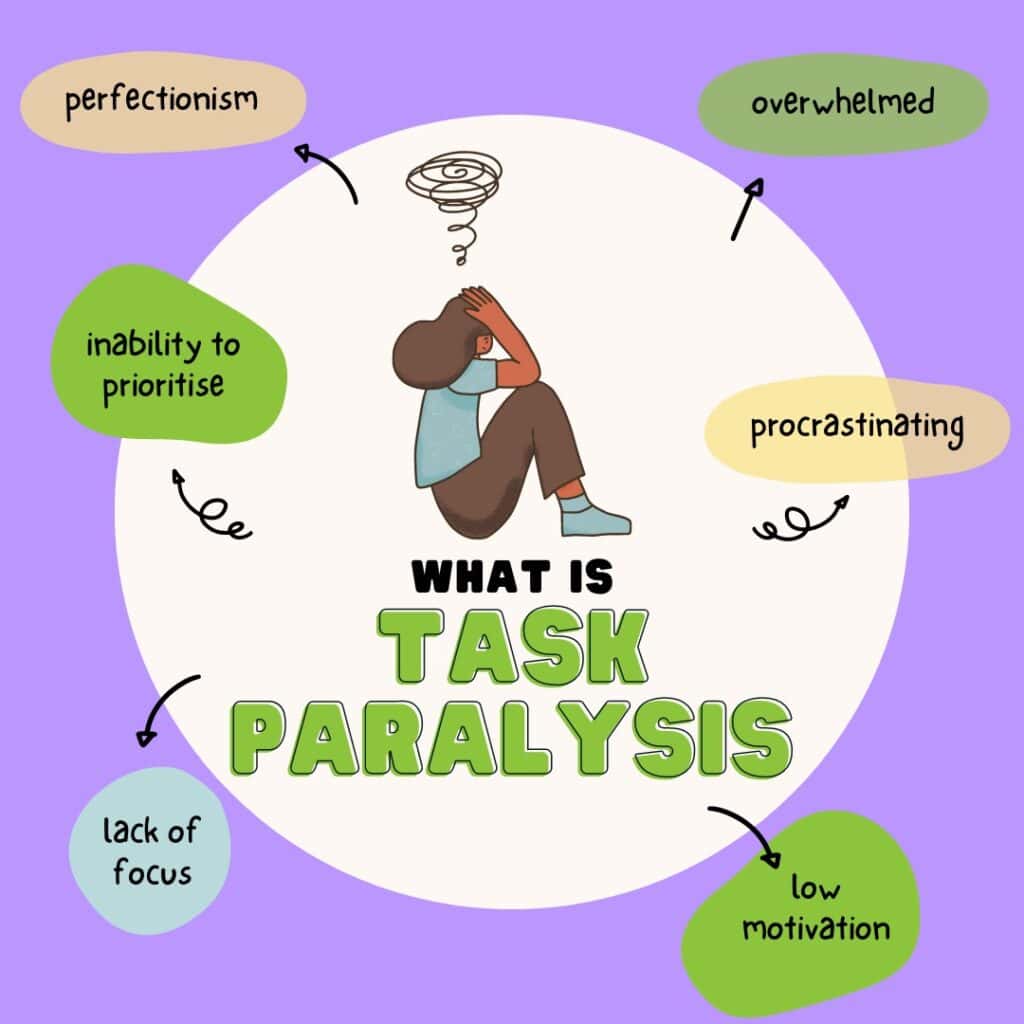ADHD task paralysis refers to the inability to start or complete tasks. This condition can manifest as feeling overwhelmed, stuck, or unable to take action, even when the task is important or urgent.
Key Characteristics
- Overwhelm: The individual may feel overwhelmed by the size, complexity, or number of tasks they need to complete.
- Inability to Prioritize: Difficulty in determining which task to start with or how to prioritize tasks effectively.
- Procrastination: Delaying the start of tasks due to anxiety, fear of failure, or lack of motivation.
- Perfectionism: The need for tasks to be done perfectly can hinder starting or completing them.
- Lack of Focus: Difficulty concentrating on a single task, leading to jumping between tasks without completing any.
- Low Motivation: Reduced interest or motivation to engage in tasks, especially those perceived as boring or difficult.
Causes and Contributing Factors
- Executive Function Deficits: ADHD often involves impairments in executive functions, such as planning, organizing, and initiating tasks.
- Anxiety: Anxiety about the task or fear of failure can exacerbate task paralysis.
- Overstimulation: An overstimulating environment can make it difficult to focus and start tasks.
- Understimulation: Tasks that are perceived as monotonous or uninteresting can be particularly challenging to start.
- Poor Time Management: Difficulty estimating how long tasks will take or managing time effectively.
Impact on Daily Life
- Academic and Work Performance: Task paralysis can lead to missed deadlines, incomplete projects, and poor performance in school or work.
- Daily Responsibilities: Difficulty in completing everyday tasks such as chores, errands, or self-care routines.
- Emotional Well-being: Feelings of frustration, guilt, and low self-esteem due to the inability to complete tasks.
Strategies to Overcome Task Paralysis
Managing ADHD task paralysis can be challenging, but several strategies can help overcome this issue. Here are some practical tips:
1. Break Tasks into Smaller Steps
- Why it helps: Large tasks can feel overwhelming and paralyzing.
- How to do it: Break down tasks into smaller, more manageable steps. Focus on completing one small step at a time.
2. Use a Timer (Pomodoro Technique)
- Why it helps: Short, timed intervals can make starting tasks less daunting.
- How to do it: Set a timer for 25 minutes (or any short duration), work on the task, then take a 5-minute break. Repeat.
3. Prioritize Tasks
- Why it helps: Knowing what to tackle first can reduce the feeling of being overwhelmed.
- How to do it: Make a to-do list and prioritize tasks by importance and deadlines. Focus on high-priority tasks first.
4. Create a Routine
- Why it helps: Consistent routines can make starting tasks more automatic.
- How to do it: Establish a daily schedule that includes specific times for work, breaks, and other activities.
5. Set Clear Goals
- Why it helps: Clear, specific goals provide direction and motivation.
- How to do it: Define what you need to achieve and set measurable and attainable goals for each task.
6. Eliminate Distractions
- Why it helps: A distraction-free environment can improve focus and productivity.
- How to do it: Identify and minimize distractions in your workspace. Use apps or tools to block distracting websites if necessary.
7. Use Visual Aids
- Why it helps: Visual aids can make tasks more tangible and manageable.
- How to do it: Use charts, checklists, or sticky notes to visualize tasks and track progress.
8. Reward Yourself
- Why it helps: Rewards provide positive reinforcement and motivation.
- How to do it: Set up a reward system for completing tasks. Rewards can be small treats, breaks, or activities you enjoy.
9. Seek Support
- Why it helps: Having someone to support you can provide motivation and accountability.
- How to do it: Share your goals with a friend, family member, or coach. Consider working with an ADHD coach or joining a support group.
10. Practice Self-Compassion
- Why it helps: Being kind to yourself can reduce stress and improve overall well-being.
- How to do it: Acknowledge that ADHD task paralysis is challenging and allow yourself to make mistakes. Focus on progress, not perfection.
11. Use Technology Tools
- Why it helps: Apps and tools can help manage tasks and improve organization.
- How to do it: Use productivity apps like Trello, Todoist, or Evernote to organize tasks and set reminders.
12. Exercise Regularly
- Why it helps: Physical activity can improve focus, mood, and energy levels.
- How to do it: Incorporate regular exercise into your routine. Even short walks can be beneficial.
Implementing these strategies can help manage task paralysis and improve productivity. It’s important to find what works best for you and adapt the strategies to your personal needs and preferences.
he National Disability Insurance Scheme (NDIS) in Australia can cover ADHD, but eligibility and the type of support provided depend on the individual’s specific circumstances and how ADHD affects their daily life. The NDIS focuses on providing support for people with a permanent and significant disability that impacts their ability to participate in everyday activities.
If you would like help with navigating the process contact us today!


